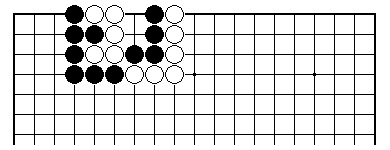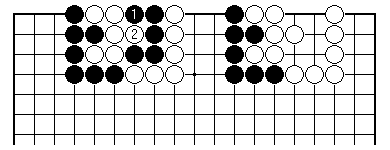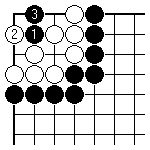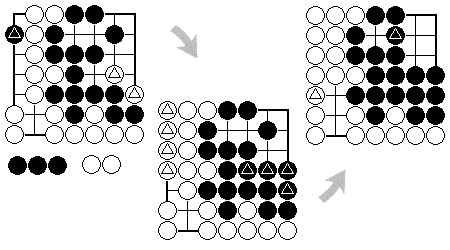

When I next see you at Dan's, you appear to have a gripe. "This envelope." Envelope? "The one you were going to explain Go on the back of. About this big, was it?" And you sketch in the air what could be a fair-sized microwave oven.
Now that's not entirely just. I haven't finished telling you the rules (you nod vigorously). But then I have told you a number of things that aren't rules, but are key things to learn. Take for example the business about two eyes to make a safe group I spoke of, last time we met. That's not a rule, but without knowledge of it you are completely at sea in a game.
"But it follows from the rules directly, doesn't it? Isn't that what you were explaining?" Well, I have to be quite careful about answering that one. Groups with two eyes will be safe, providing the owner doesn't fill in an eye in a moment of madness. Groups that can form two eyes, unstoppably, will be safe too. But there is another route to safety that does come up. So there isn't a rule that you can derive from the basics about capture that says "without two eyes you die".
"There isn't?" No, and here's why.

In this position Black and White have to live and let live. The black and white chains inside each have two liberties. There is no percentage in either trying to capture the other, by fighting on.

Here Black tries and is captured at once (final position on the right). The Japanese word seki is in common use for this kind of impasse or local stalemate.
At this point GOLD, imagining quite baselessly that I'm in some sort of difficulty, strolls over. "Lads off the farm can understand it, but profound scholars cannot master it", he says, as if letting us into a secret. Right, that's a proverb about Go.

And he shows us this, a common occurrence in games of novice players. Black makes a seki of a different kind inside an apparently safe White corner. Now the lads off the farm like this sort of thing, the profound scholars go away and fret about its implications. To begin with, one should be laddish enough to enjoy unexpected tactics.
I really wanted to explain the scoring system. However, this little diversion will turn out not to be wasted. Here at Dan's we use the Japanese system: that's also the case over most of the western world, and also in South Korea, where amateur Go thrives and there is even a Go cable TV channel. One scores for empty territory surrounded, plus prisoners taken. (There is another possibility, which is to score or total area controlled with nothing for prisoners, which therefore need not be retained. That is the Chinese system. It is nearly but not exactly equivalent: most games give the same result however you score them.)
Scoring applies only when the game is over, naturally enough. Serious players often are heard saying "I was ten points behind, so it was time to invade" and suchlike. This isn't to impress. Part of the skill lies in keeping an approximate running score as you play. The Japanese system is handier for that, with smaller numbers involved too. Even if you don't yet aspire so high, knowing how the game is scored naturally determines your state of mind in deciding what is worth doing. The board is big, and plays in different parts of it will be worth much or little.
Learning Go has often been likened to climbing a mountain. We are still amongst the foothills here. Compared to what is to come (though maybe I shouldn't say this too loud) the business of which scoring system is more like a molehill, something that gets obscured by the polemics this topic regularly generates. Which isn't to say it can't trip you up.
Back to scoring: more things to say to fill out the rules and procedure.
Your territory is by definition the empty space inside your groups capable of forming two eyes. What do you do about seki? Leave it firmly alone: stones in a seki situation survive, but that part of the board is just left out of counting.
End-of-game tidying up: you may pass at any time in a game of Go, consecutive passes by the two players being taken as agreement that the game is over. Then hopelessly lost stones inside the opponent's territory are removed as prisoners. Or perhaps more clearly, you tell them to surrender.
Rearrangement: The score is territory plus prisoners taken. Two more steps are practical but not mandatory before counting the game.
Now just count territory, or observe that someone has none left. (In the very rare case the whole board is full, you should count remaining prisoners; in practice the players will have had to exchange equal numbers of prisoners to keep playing.)
Finally add komi to White's score. By convention Black starts. White is given extra points called komi (6 here at Dan's) as compensation. The larger score wins. So a draw is possible - in tournaments komi might be set as 6.5 instead to avoid this - though not very common. The margin of victory isn't specially significant, and the individual Black and White scores aren't informative at all.

Here is a 7x7 example of the usual procedure. In the left-hand diagram both players have just passed. Black had taken the two white stones and White the three black stones shown below the diagram, during the course of the game. In passing the players were agreeing that the stones with triangles on were hopeless (if not the owner should play on). In the centre those stones have been removed and then all the prisoners of both colours sent back into 'home' territory. Finally, on the right, some harmless shuffling makes the score on the board apparent: Black has 7, White 3, so with 6 komi to White, it's a White win by 2 points.
First published 17 February 2000 as On Your Side on MindZine,
Go Learning
© Charles Matthews 2000.